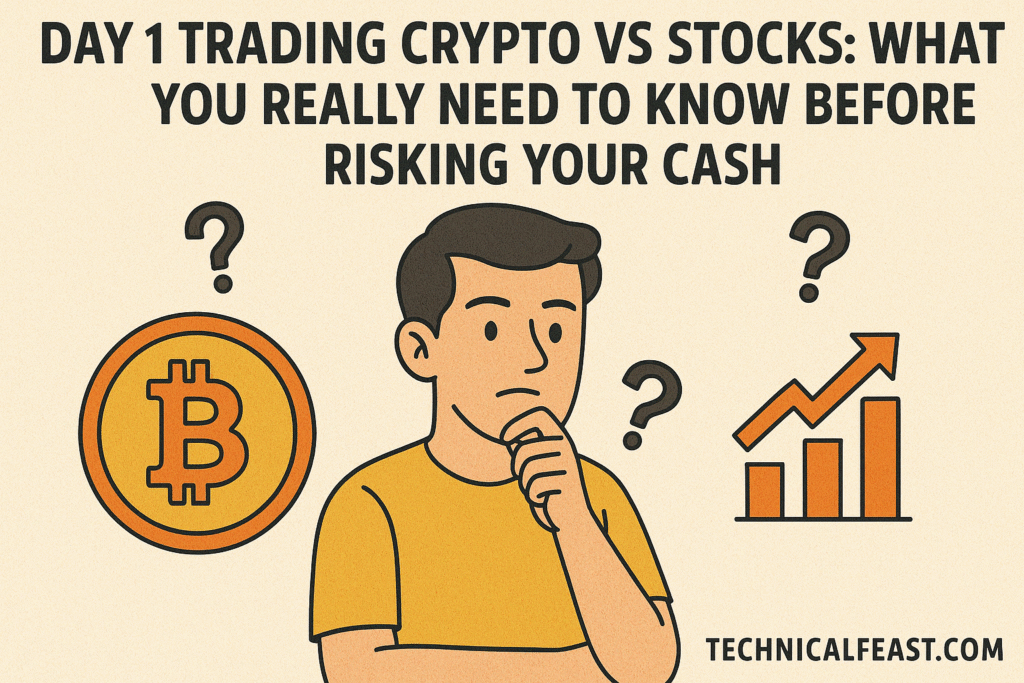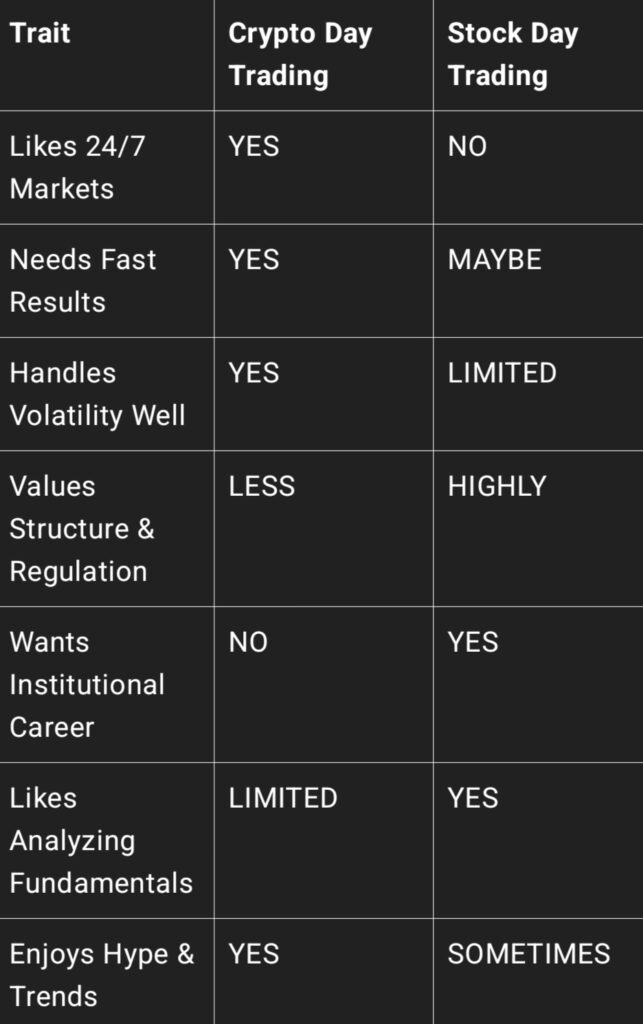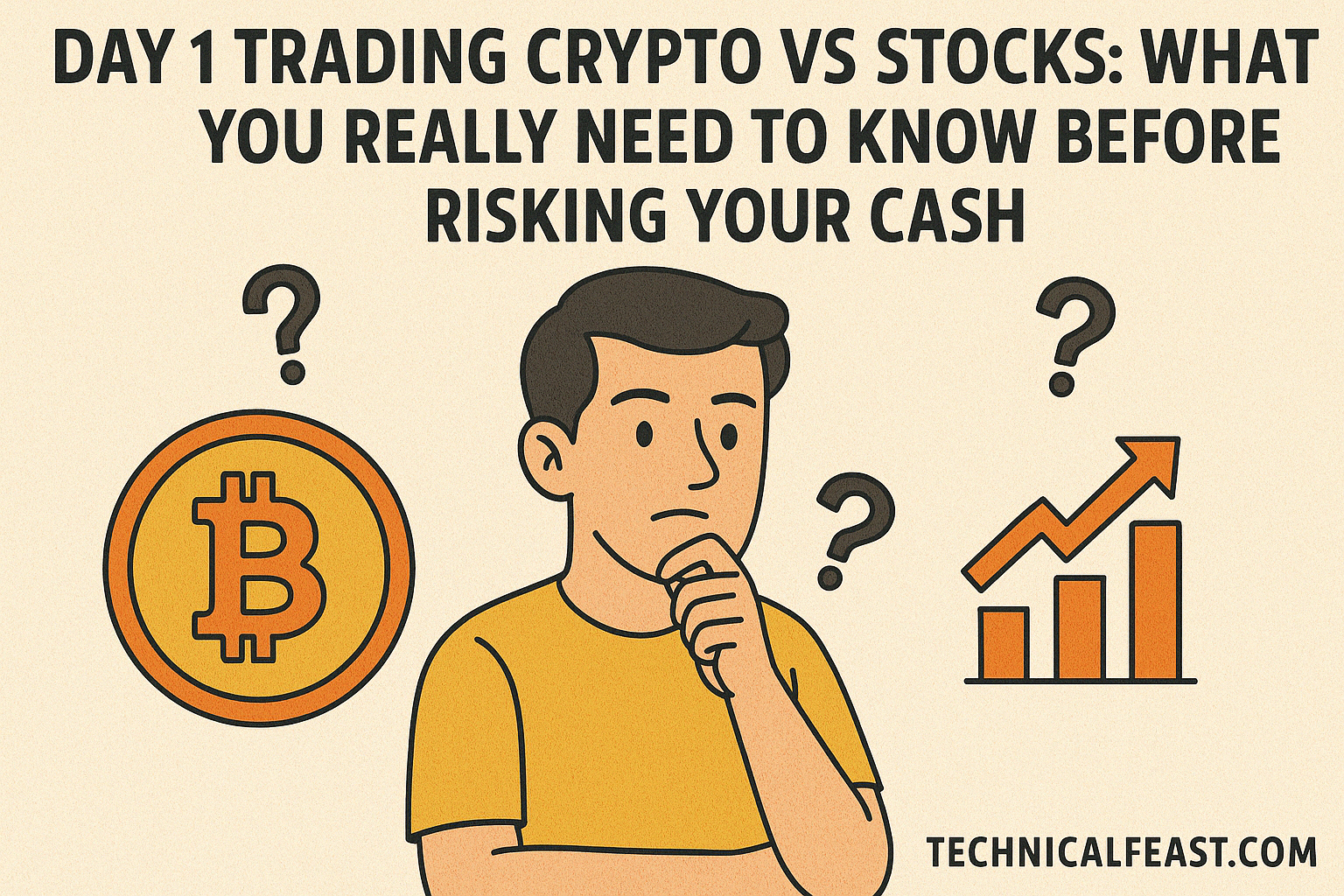Table of Contents
Trading seems exciting when you look at flashy screenshots on social media—green charts, big numbers, a coffee mug next to a MacBook. But when it comes to actual results, most beginners quickly realize that day trading is less about thrill and more about strategy and discipline.
And one of the biggest dilemmas new traders face?
Day trading crypto vs stocks — which one makes more sense?
As someone who’s dabbled in both (and lost money in both too, let’s be honest), I want to break this down for you—not with hype, but with real insights, factual comparisons, and some hard-earned lessons.
The Basics: What Is Day Trading in Crypto and Stocks?
Let’s start with the simplest definition.
Day trading is the act of buying and selling a financial instrument within the same day. You close your position before the market closes—avoiding overnight risk.
But the platform and asset type change the game completely.
- Day trading stocks means you’re trading equity (company shares) listed on a regulated exchange (like NYSE or NASDAQ).
- Day trading crypto involves trading cryptocurrencies (like BTC, ETH, SOL) on decentralized or centralized crypto exchanges (like Binance, Coinbase).
The major difference lies in volatility, regulation, market hours, and liquidity.
And trust me, these differences matter—especially when your real money is involved.
Market Hours: Crypto Never Sleeps, But Stocks Nap Daily
One of the biggest practical differences in day trading crypto vs stocks is the market timing.
- Stock markets operate from 9:30 AM to 4:00 PM EST (if you’re in the U.S.), Monday to Friday. That’s about 6.5 hours per day, and they’re closed on holidays.
- Crypto markets are open 24/7—yes, even during your family dinner or New Year’s Eve.
What This Means:
- If you’re a student, 9–5 employee, or living in a different timezone, crypto gives you more flexibility.
- But that flexibility is a double-edged sword. It’s easier to fall into overtrading or checking prices obsessively at 2 AM.
In my early crypto days, I remember waking up at 3 AM just because I dreamt Bitcoin had crashed. (Spoiler: it didn’t. I just had anxiety.)
Volatility: The Good, the Bad, and the Dangerous
Let’s talk movement—because without movement, there’s no profit.
- Crypto is way more volatile. It’s not uncommon for coins to move 10%+ in a single day.
- Stocks, especially large-cap ones, move slower—typically 1–3% per day, unless there’s news or earnings.
Why This Matters:

- Higher volatility = higher risk and higher reward.
- If you’re trading with leverage (which both crypto and stock brokers offer), that risk multiplies fast.
Real Data Example:
In 2023, Bitcoin saw a 15% daily move during the ETF approval rumors. In the same timeframe, Apple (AAPL) moved only 2.3% on its biggest day.
So if you’re someone who thrives in chaos and reacts fast—crypto might feel like a playground.
But if you prefer slower, calculated setups—stocks are more your speed.
Leverage: Power Tool or Disaster Button?
Here’s where things get spicy.
Both markets offer leverage. But the amount and risk exposure differ drastically.
- Crypto platforms like Binance, Bybit, or OKX allow up to 100x leverage (which is insane).
- Stock brokers like Robinhood or Interactive Brokers are limited by regulations, typically up to 2x or 4x for retail traders.
What You Need to Know:
Using 10x leverage in crypto means a 10% move in the wrong direction liquidates your position.
Yes, I’ve seen traders go from $1,000 to $0 in minutes.
In stocks, while you can lose money, margin calls offer some protection. Regulators (like FINRA and the SEC) enforce safety limits.
So in the day trading crypto vs stocks comparison, crypto offers more freedom—but with more rope to hang yourself if you’re not careful.
Liquidity and Slippage: Can You Get In and Out Fast Enough?

Liquidity means: how fast can you buy or sell without the price moving too much?
- Stock market liquidity is generally high—especially in large-cap stocks like AAPL, MSFT, AMZN.
- Crypto liquidity varies wildly. You can have smooth trades on BTC or ETH, but small altcoins? They can have huge spreads.
Case Study:
I once tried to day trade a low-cap coin on KuCoin. I entered a position with $1,000. When I tried to exit, I lost 5% due to slippage alone—not price movement, just lack of liquidity.
In day trading crypto vs stocks, if your goal is fast entries and exits without price distortion, stocks are safer—but only if you stick to high-volume tickers.
Regulation and Tax: The Hidden Monsters
When you day trade crypto or stocks, you’re not just trading the markets—you’re also entering legal territory.
- Stock trading is heavily regulated. You must follow pattern day trading rules in the U.S. (minimum $25K capital), and brokers report directly to the IRS or relevant tax authorities.
- Crypto trading is still a regulatory gray zone in many countries. Some exchanges operate offshore. Taxation depends on your country—some treat it as property, others as income.
My Experience:
I once made ₹14,000 from a meme coin in 2022 and forgot to report it. My CA flagged it later, and I had to pay penalty interest.
So regardless of whether you choose day trading crypto vs stocks, get a basic understanding of tax rules in your region. Seriously—it’ll save you a headache.
Community and Education: Where Are the Smarter Traders?
This might sound odd, but who you’re trading with matters.
- Stock traders usually come from traditional finance, follow structured plans, and use tools like Thinkorswim or TradingView with discipline.
- Crypto traders can be a mix: young techies, gamblers, developers, and yes—some really smart quants too.
But here’s the catch…
In crypto, you’ll see more noise, more hype, more Discord pumps, and random YouTube influencers shouting “100x GEM INCOMING!”
In stocks, while pump-and-dumps happen, the bar for BS is slightly higher because of legal scrutiny.
So in the battle of day trading crypto vs stocks, if you’re looking for learning depth, structure, and quality tools, stocks might give you a better base.
Which Is Easier to Learn: Crypto or Stock Day Trading?
So if you ask me…
“Which one is easier to learn properly?”
Stocks win. But only because there’s more established guidance, rules, and mentorship.
In the long game of day trading crypto vs stocks, those who treat trading like a business—with discipline, logs, and reflection—end up ahead. And the stock trading ecosystem is better suited for that structured learning process.
But if you’re tech-savvy, love learning by doing, and can handle big emotional swings, crypto might be your wild training ground.
What Type of Trader Are You? Personality Match Matters
Here’s a quick self-assessment to figure out which style suits you more.

This table isn’t gospel—but it can help. In my experience, impulsive personalities are drawn to crypto, while analytical thinkers often lean toward stocks.
But whichever path you pick, the real currency is your consistency, not the asset.
Daily Routine of a Successful Day Trader: Crypto vs Stocks
Let’s look at a real-world example of how a full-time trader’s day could look in both markets.
Crypto Day Trader Schedule (Flexible & Global)
- 7 AM – Wake up, check overnight market movements
- 8 AM – Review news from Twitter/Telegram (crypto is social)
- 9–12 PM – Analyze setups on BTC, ETH, trending altcoins
- 1–4 PM – Trade active breakouts (scalping or short-term swings)
- 5 PM Onward – Passive monitoring with alerts set
- 10 PM – Final analysis, log trades, prep for tomorrow
Crypto traders often trade during peak volatility hours, depending on global volume.
Stock Day Trader Schedule (India example)
- 8 AM – Read global market news, check SGX Nifty
- 9 AM – Watch pre-market price action
- 9:15–10:30 AM – Main trading window (volatility spike)
- 12–2 PM – Avoid trading; low volume
- 2–3:30 PM – Monitor setups and exit trades before close
- Post-market – Review trade journal, prep next watchlist
Stock traders work with defined hours and more focus on discipline over emotion.
In comparing day trading crypto vs stocks, structure and routine play a huge role in emotional control and long-term consistency.
Day Trading Crypto vs Stocks—Which One Wins?
Let’s be honest—there’s no one-size-fits-all answer here.
Both crypto and stock day trading can be profitable, exciting, and risky. But they serve different kinds of traders.
Choose Crypto if you:
- Want flexibility (24/7 trading)
- Enjoy fast-moving markets
- Can manage high volatility and big swings
- Prefer global, decentralized finance
Choose Stocks if you:
- Thrive in structure and regulation
- Want to build a long-term, legal trading career
- Prefer analyzing technical charts and fundamentals
- Don’t want to check charts at 2 AM
If you’re just starting and want stability, transparency, and education, stock trading wins.
But if you’re a fast learner who’s okay with risk and loves chasing trends, crypto will challenge and reward you (sometimes brutally).
Remember, the battle of day trading crypto vs stocks isn’t about finding the “better” one. It’s about finding the one that fits you.
Beginner Tips: Starting Smart in Both Worlds
If You’re Starting in Crypto:
- Start on spot markets, not futures.
- Use exchanges like Binance, CoinDCX, or WazirX with strong liquidity.
- Avoid leverage until you’ve traded successfully for 3–6 months.
- Don’t trade low-cap altcoins unless you’re ready for wild swings.
- Always use stop-loss and protect your capital.
If You’re Starting in Stocks:
- Pick brokers like Zerodha, Upstox, or Groww for Indian stocks.
- Learn technical indicators like RSI, VWAP, and MACD.
- Start with large-cap stocks like Reliance, TCS, Infosys.
- Don’t overtrade. 1–2 quality trades a day are more than enough.
- Follow SEBI rules and understand pattern day trading rules if abroad.
Whatever you choose, journal your trades. Track your wins and your losses. That’s how growth happens.
From Confusion to Clarity
When I first heard about day trading in 2020, I thought, “This is it. I’ll make ₹10,000 a day and retire in two years.”
I started with crypto. Made ₹4,500 on my first trade.
Felt like a king.
Next day, lost ₹7,000. I panicked, doubled my position. Lost ₹11,000 more.
That’s when I realized—trading isn’t about being lucky, it’s about being consistent.
I switched to stocks. Slower market, but more structure. I started building strategies, following price action, studying volume, and most importantly—controlling my emotions.
And slowly, both markets started making sense.
So here’s what I’ve learned:
- It’s not about what you trade. It’s about how you trade.
- Don’t chase profits. Chase risk management.
- Avoid FOMO. Avoid revenge trading. Avoid guru traps.
- And don’t compare your journey with others. Everyone’s chart looks different.
FAQs: Day Trading Crypto vs Stocks
Q1: Can I trade both crypto and stocks together?
Yes, many traders do. But if you’re a beginner, focus on one market first. Managing two volatile worlds without a system can lead to burnout.
Q2: Is day trading crypto more profitable than stocks?
Potentially yes—due to higher volatility. But it’s also riskier. Most crypto day traders lose money if they don’t follow a solid plan.
Q3: Do I need a lot of money to start day trading?
No. You can start with as little as ₹1,000 in crypto or ₹5,000–₹10,000 in stocks. But start with learning, not just capital.
Q4: Are there taxes on crypto day trading?
Yes. Most countries now treat crypto gains as taxable income or capital gains. Always declare your profits, and consult a CA.
Q5: Is day trading better than long-term investing?
Not necessarily. Long-term investing creates wealth. Day trading creates income (if done well). Both have a place in your financial journey.
Read more blog.




Leave a Reply